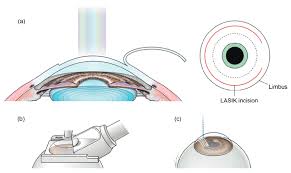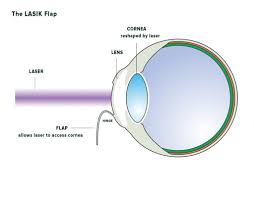Table of Contents
ToggleCan LASIK Candidates Fly High with AFCAT? Understand the Vision Requirements
If you’re an AFCAT aspirant dreaming of soaring through the skies, you might be wondering whether LASIK surgery could affect your eligibility.
LASIK, a popular corrective eye surgery, has helped millions achieve perfect vision.
But how does it align with the stringent physical requirements of the Air Force Common Admission Test (AFCAT)?
In this comprehensive guide, we’ll explore whether candidates who have undergone LASIK are eligible for commissioning in the Air Force and what specific criteria must be met. Whether you’re an aspiring pilot, a military professional, or simply interested in eye care, read on to uncover the facts.
Understanding LASIK and Its Popularity
What is LASIK Surgery?
LASIK (Laser-Assisted in Situ Keratomileusis) is a surgical procedure designed to correct refractive errors such as myopia, hyperopia, and astigmatism. By reshaping the cornea, LASIK enhances the focusing of light rays on the retina, thereby resulting in improved visual clarity.
It’s a quick procedure, often completed within minutes, and recovery is typically rapid. Many people choose LASIK for the freedom it offers from glasses and contact lenses.
Why is LASIK Popular Among Young Adults?
Young adults, particularly those pursuing active careers, appreciate LASIK’s ability to enhance their lifestyle.
Whether for sports or professional requirements like those in the Air Force, having a clear vision without the hassle of corrective eyewear is a game-changer. LASIK offers a long-term solution, reducing dependency on glasses or contacts, which is crucial for those looking to meet specific physical criteria for roles like pilots or navigators.
Safety and Success Rates of LASIK
The safety and effectiveness of LASIK are well-documented, with success rates exceeding 95%. Most patients achieve 20/20 vision or better post-surgery, and complications are rare.
With advances in technology, procedures like Femto LASIK and SMILE offer even greater precision and outcomes.
However, potential candidates must understand that individual suitability, particularly for specialized roles like those in the Air Force, requires careful evaluation.
AFCAT and Vision Requirements
Introduction to AFCAT
The Air Force Common Admission Test (AFCAT) is a gateway for aspiring officers in the Indian Air Force. It covers multiple branches, including flying, ground duty (technical), and ground duty (non-technical).
Beyond academic and physical assessments, specific medical standards must be met, particularly concerning vision and overall fitness.
Vision Standards for AFCAT Aspirants
Vision is a critical aspect of the selection process for AFCAT candidates.
Precise vision is essential for flying duties, where split-second decisions rely on perfect sight.
The requirements are stringent to ensure safety and efficacy in various operational scenarios. While LASIK offers an opportunity for those with refractive errors to meet these standards, the eligibility criteria are specific and must be adhered to.
Why Vision Matters in the Air Force
In the Air Force, vision isn’t just about seeing clearly; it’s about perception, depth, focus, and the ability to respond to dynamic environments.
Aviators often face challenging visual conditions, and any impairment could jeopardize both individual and mission safety. Thus, the Air Force’s rigorous standards are designed to ensure that all personnel have optimal visual capabilities.
Is LASIK Allowed in AFCAT?
The Eligibility of LASIK Candidates
Yes, candidates who have undergone Keratorefractive Surgeries, including LASIK, may be considered fit for commissioning in the Air Force, across all branches. However, there are specific criteria that must be satisfied, to ensure that the surgery hasn’t compromised the candidate’s visual acuity or ocular health.
Key Criteria for LASIK Candidates
Several criteria govern the eligibility of LASIK candidates for AFCAT:
- Refractive Error Limitation:
- Candidates with high refractive errors (>6D) before surgery are excluded.
- Post-surgery residual refraction should not exceed +/- 1.0 D Sph or Cyl for branches allowing correctable errors.
- Age and Surgery Timeline:
- Surgery should not have been performed before the age of 20.
- At least 12 months must pass after the surgery to ensure stability and the absence of complications.
- Ocular Measurements:
- The axial length of the eye must be ≤26 mm.
- Post-surgery corneal thickness must be ≥450 microns.
- Prohibited Procedures:
- Radial Keratotomy (RK) and cataract surgeries disqualify candidates from Air Force duties.
Official Guidelines and Considerations
The Air Force’s official guidelines carefully outline these requirements, emphasizing the need for meticulous assessment. Candidates considering LASIK should consult with qualified ophthalmologists and ensure documentation of their pre-and post-operative status aligns with these standards.
Navigating the LASIK Process for AFCAT
Pre-Surgery Assessments and Considerations
Before undergoing LASIK, candidates should engage in thorough consultations with eye care professionals. Evaluating factors like refractive error, corneal thickness, and overall eye health is crucial.
Clear communication with the surgeon about future aspirations in the Air Force can guide the decision-making process, ensuring all criteria are met.
Post-Surgery Recovery and Monitoring
Recovery from LASIK is generally smooth, but consistent follow-up care is essential.
Regular check-ups help monitor stability and address any potential complications. Providing documentation of these assessments will be necessary when applying for AFCAT, demonstrating compliance with the required timeline and ocular health criteria.
Preparing for AFCAT with LASIK
Armed with successful LASIK results, candidates can focus on their AFCAT preparations. Maintaining good eye health, adhering to follow-up schedules, and ensuring all medical records are up-to-date will streamline the application process.
Engaging with preparatory resources and seeking guidance from mentors or previous aspirants can also enhance readiness.
Alternatives to LASIK for AFCAT Aspirants
Other Corrective Eye Procedures
While LASIK is popular, other procedures like PRK, Femto LASIK, and SMILE also offer viable solutions for vision correction. These methods may be suitable for candidates with specific eye conditions or preferences.
Understanding the nuances of each procedure, including recovery times and eligibility, can help candidates make informed choices.
Contact Lenses and Glasses
For those unable or unwilling to undergo surgery, corrective eyewear remains an option. Certain branches within the Air Force permit correctable errors, allowing candidates to use glasses or contact lenses. Ensuring these options provide optimal vision and comfort is essential for meeting the demands of the role.
Natural Vision Improvement Techniques
Some candidates explore natural methods for enhancing vision, such as eye exercises, nutrition, and lifestyle changes. While these approaches may offer marginal improvements, they are not substitutes for medical interventions in meeting AFCAT standards. However, they can complement other efforts to maintain overall eye health.
Common Misconceptions About LASIK and AFCAT
Debunking LASIK Myths
Many misconceptions surround LASIK, especially regarding its implications for military careers. Contrary to belief, LASIK does not automatically disqualify candidates from AFCAT. Understanding the specific criteria and the Air Force’s acceptance of modern surgical advancements can dispel these myths.
Clarifying AFCAT Vision Requirements
AFCAT’s vision standards are often perceived as overly restrictive, but they aim to ensure safety and performance. Misinterpretations can arise, particularly from outdated sources.
Staying informed through official channels and consulting with military recruitment experts ensures an accurate understanding of these requirements.
Addressing Concerns About Surgery and Performance
Some candidates worry that surgery might impact their visual performance during operational duties. However, with proper procedures and adherence to guidelines, LASIK and similar surgeries have proven to enhance visual capabilities, supporting candidates in achieving their best performance.
Expert Opinions and Testimonials
Insights from Eye Care Professionals
Ophthalmologists and eye surgeons emphasize the benefits of LASIK for those pursuing demanding careers like flying. Their expertise underscores the safety and effectiveness of the procedure when performed on suitable candidates, ensuring alignment with AFCAT’s vision requirements.
Experiences from AFCAT Candidates
Hearing from previous AFCAT candidates who have successfully undergone LASIK can provide valuable insights. Many have shared positive experiences, highlighting how the procedure facilitated their acceptance into the Air Force and enhanced their career prospects.
Industry Trends and Technological Advances
The field of corrective eye surgery continues to evolve, with new technologies offering enhanced precision and outcomes. Staying abreast of these developments allows candidates to consider the best options for their unique needs, ensuring they remain competitive and compliant with AFCAT standards.
Conclusion and Next Steps for AFCAT Aspirants
Summing Up Key Points
Understanding the relationship between LASIK and AFCAT eligibility is crucial for aspiring Air Force personnel. By adhering to the outlined criteria and engaging in thorough pre-and post-operative care, candidates can position themselves advantageously for selection.
Taking Action and Exploring Further
Those considering LASIK should consult with both eye care professionals and military recruitment advisors. Exploring alternative corrective methods and staying informed about technological advancements can offer additional pathways to success.
Resources for Continued Learning
For more information, candidates can access official Air Force guidelines, attend informational sessions, and engage with online communities of current and past AFCAT aspirants. Building a network of support and resources will enhance their preparation and confidence as they pursue their dreams of joining the Indian Air Force.













